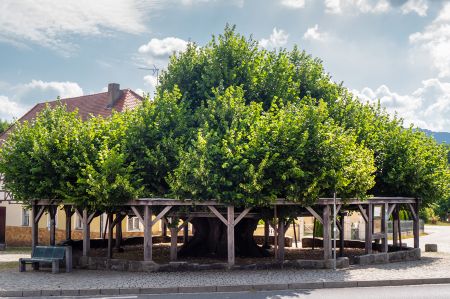Tanzlinden - trees of historically special importance and function
- Written by Portal Editor
On our tours through small towns and communities, we often noticed linden trees that had been planted in village squares for special occasions and therefore, in addition to their function as a source of shade and oxygen, must have other meanings in the lives of the residents.
Depending on the type, linden trees reach a maximum growth height of between 15 (e.g. the Crimean linden) and 40 meters. The achievable trunk diameter also varies from species to species, usually between 1 and 1.8 meters. Lime trees can reach an age of up to 1000 years in favourable locations.
Linden Leaf Tea ("Ihlamur Çayı") a very popular herbal tea

There are studies on its ingredients, for example, lime blossom tea has a soothing effect on coughing and soothes a sore throat due to the mucilage in catarrhs of the respiratory tract. Other ingredients such as glycosides give lime blossom an antispasmodic, analgesic and anti-inflammatory effect.

The linden tree was considered a sacred tree by both the Slavs and the Germans, which is popularly attributed to the goddess Freya, but this cannot be clearly proven scientifically. Today, around 850 places or districts in Germany have names that can be traced back to the lime tree, for example the name of the city of Leipzig is derived from the Sorbian word Lipsk and means lime tree place. The Sorbs have many other connections to the linden tree, so the linden leaf is also a symbol of the Sorbian people.
Idea for the German Dance Linden Route born in Limmersdorf
Lime trees used to be planted in many places across Central Europe, forming the centre of the town and serving as a meeting place in the village for young and old. Current news was exchanged here, brides were also presented here. A custom of the Middle Ages was also to plant a peace linden tree after wars or epidemics, so linden trees were planted in many places after the Franco-Prussian War of 1870/71. In Ponitz, Thuringia, the "Peace Linden Tree on the Dreierhäuschen" is a reminder of the Peace of Westphalia.
It quickly turned out that in the region of Upper Franconia-Thuringia along the route from Limmersdorf via Langenstadt and Peesten to Effelder, Sachsenbrunn and Oberstadt - the last six remaining old and authentic locations, the classics so to speak - this old tradition was most intensively developed and has been maintained in the most sustainable way to date. Along this "Route of the Classics" there are other places where linden trees still exist, which prove the formerly widespread distribution of linden trees (Franconian Switzerland, Nördlicher Rennsteig).
Hohenlohe in Baden-Württemberg, a region traditionally closely linked to Franconia, has emerged as the third region in which this tradition was and is demonstrably long and deeply rooted. A row of linden trees in Westphalia, which extends to the Lower Rhine, but which have no verifiable roots in the regions described above - formerly also used for dance purposes - is out of the ordinary.
Stepped lime trees around Schweinfurt
The stepped linden trees around Schweinfurt are a striking feature, and some villages in Thuringia have obviously been based on them. There is a row of multi-tiered linden trees, which are often referred to as dancing linden trees, but actually never fulfilled this function.
The proclamation of the German Dance Linden Route in 2010 should be a cornerstone for the work of the German Dance Linden Museum. All communities, associations and individuals who are interested in the topic at one of these locations are cordially invited to participate. Over time, this cooperation should result in a great map and an organization of whatever kind, which ensures that the locals and visitors are comprehensively informed about the Tanzlinden at all locations.
An interesting idea to keep this ancient heritage alive.
Please read as well:
The Waterfall of Edessa - short trip into the city
Schönbrunn Palace and the Roman Ruin
